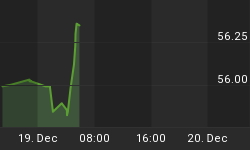The following article was published for the benefit of subscribers on Saturday November 23rd 2009. All indices and commodities are trading inversely to the US dollar index at present, so as long as the defined trend of the USD remains intact, everything else should trade inversely. Gold is presently in a parabolic move, which has repercussions mentioned a few days earlier...on to analysis of the S&P 500 index:
The daily chart of the Gold miner's bullish percentage index is shown below, with the HUI shown in green. Full stochastics 1, 2 and 3 are shown below in order of descent, with the %K above the %D in 1 and beneath the %D in 2 and 3. Based upon positioning of stochastics 2 and 3, it appears that there may be a pause in the degree of bullishness.
Figure 1
The daily chart of the CBOE options equity put/call ratio is shown below, with the S&P 500 index shown in black. The put call ratio is forming another pennant formation (lines not drawn), indicating the possibility of a breakout to the upside or downside in the not too distant future. The full stochastic shown below (longer-term setting) has the %K marginally above the %D...notice how the %K and %D have been intertwined for most of November; a break of the %K beneath the %D would be bullish, while an increased angle of ascent above the %D would be bearish.
Figure 2
The daily chart of the S&P 500 index is shown below, with all three upper Bollinger bands in close proximity to each other, suggestive that further downside pressure could persist into next week. Full stochastics 1, 2 and 3 are shown below in order of descent, with the %K above the %D in stochastics 1 and 2 and beneath the %D in 3. It is possible the S&P 500 index declines to 1040-1050 this week or next before setting up the stage for "the Santa Claus Rally".
Figure 3
The weekly chart of the S&P 500 index is shown below, with the upper 21 and 34 MA Bollinger bands in close proximity to each other. Lower Bollinger bands continue to rise up to the index; the lower 55 MA BB curled down recently, confirming the November breakout and when it curls back up, a top will have been put in place. The lower 21 MA BB is still at quite a low level relative to the index, suggestive that more time is required for it to get within close proximity to see enough reduction in volatility to trigger a downward move. Full stochastics 1, 2 and 3 are shown below in order of descent, with the %K above the %D in 2 and 3 and beneath the %D in 1...the %K in stochastic 1 appears to be hooking up (or at least trying). Based upon the length of the upward trend in the S&P 500 index, a top cannot be precisely determined until the %K in stochastic 2 falls beneath the %D. The %K in stochastic 3 is well above the %D, with no indication that a top has been put in place. For now, the weekly chart of the S&P 500 index suggests the upward trend remains intact.
Figure 4
The monthly chart of the S&P 500 index is shown below, with all three lower Bollinger bands falling beneath the index, suggestive that an important bottom was put in place in 2008. Full stochastics 1, 2 and 3 are shown below in order of descent, with the %K above the %D in 1 and beneath the %D in 2 and 3. Based upon positioning of the %K in stochastic 3, it could take another 12-16 months before the next bottom is put in place. The monthly chart suggests the S&P 500 index is in an uptrend and until the %K in stochastic 1 begins to roll over, nothing more need be said.
Figure 5
The mid-term Elliott Wave count of the S&P 500 index is shown below, with the thought pattern forming denoted in green. The S&P could fall back to 1040-1050 over the course of the next week before grinding higher. I am anticipating a top around the end of 2009, but I again stress that it could very well be stretched out into late February/early March 2010 before topping out.
Figure 6
The long-term Elliot t Wave count of the S&P 500 index is shown below, with vertical lines marking the time wave [A] took to form. Based upon this observation, wave [B] MUST go until late April to be considered a correct count, otherwise wave [A] becomes wave [W] and the present move up is wave [X]. If wave [X] were to happen, it should retrace 61.8% of the decline or move to just above 1200...if the wave [B] scenario is correct, the S&P should rally into April. Either or, until proven otherwise, the S&P has further upside or further sideways action so until either of the above scenarios develop (if 1200 is hit, exit all trading positions accordingly), the upward trend of this move remains intact.
Figure 7
That is all for today....back tomorrow AM.
















